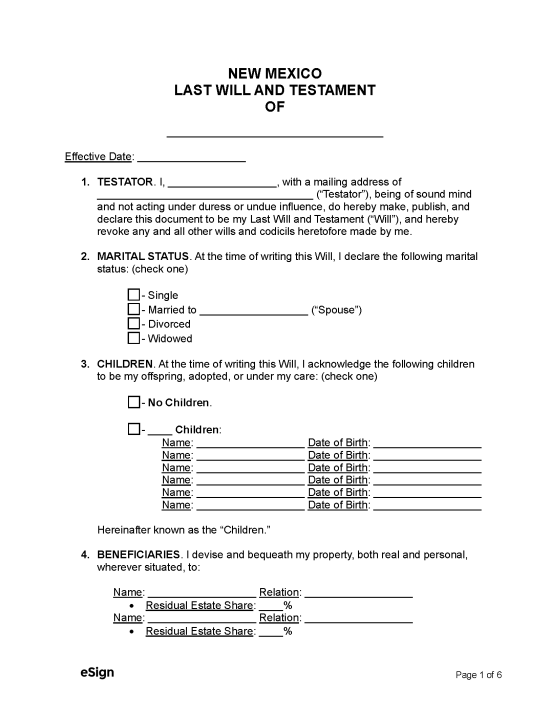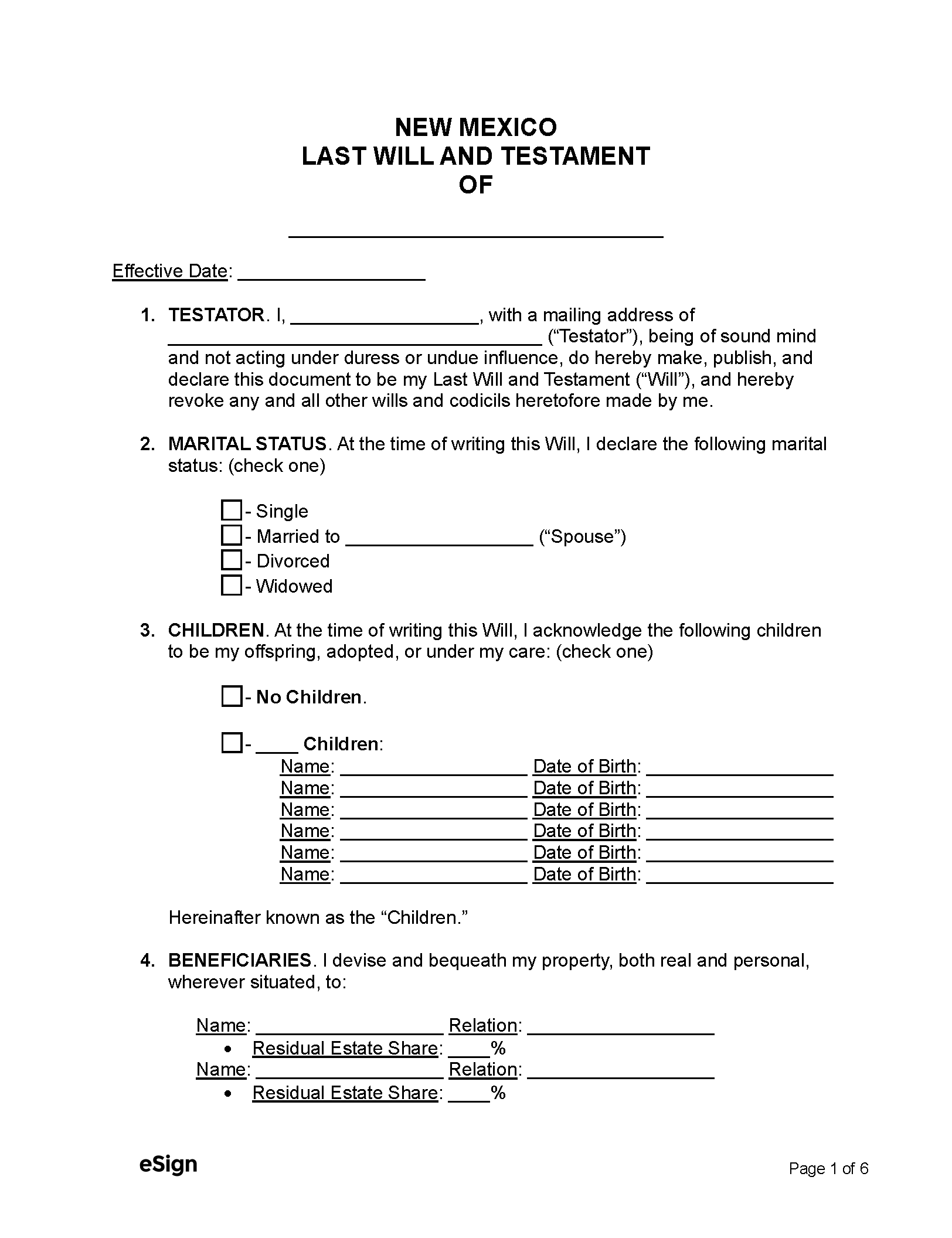A New Mexico last will and testament outlines a person’s wishes and instructions for the distribution of their property after death. This document appoints a personal representative to manage and distribute the estate, and names beneficiaries who will inherit their assets through probate.
A will can be created by any person eighteen years of age or older (or an emancipated minor) who is of sound mind.[1]
State Laws
Holographic Wills – Holographic wills are not accepted in the state of New Mexico unless they follow the legal signing requirements.
Revocation – To revoke a will, the testator must create a new will or a document expressly revoking the will. They may also cancel a will by destroying the original document with the intention of revoking it.[2]
Signing Requirements – A will must be signed by the testator (or an individual directed by the testator) and two witnesses.[3]
Probate Process in New Mexico (11 steps)
In most cases, a will must be probated within three years of the decedent’s death, and the process will take six months to one year to complete.[4][5] The steps below summarize an informal probate process through county probate court; all formal or contested probate cases are handled by the district court instead.[6]
- Demand for Notice
- Filing for Probate
- Acceptance
- Notice of Probate
- Notice to Creditors (If Applicable)
- Inventory
- Family Allowances
- Taxes
- Payments and Distributions
- Accounting
- Closing Probate
1. Demand for Notice (If Applicable)
If the total value of the estate does not exceed $50,000, a decedent’s estate can be distributed outside of probate by using an Affidavit for Collection of Personal Property.[7]
Before filing for probate, the personal representative named in the testator’s will should check with the clerk of the district court in the county where probate will take place to see if any demand for notice has been filed. A demand for notice is a form completed by an interested party who wishes to receive any order or filing pertaining to the probate of the decedent’s estate.[8]
If a demand for notice is filed after probate has started, the court clerk will mail a copy of the demand to the personal representative.
2. Filing for Probate
To initiate the informal probate of a decedent’s will, the following forms must be filed with the probate court in the county where the decedent died[9][10]:
- Original will
- Application for Informal Probate and Appointment of Personal Representative
- Order for Informal Probate of Will and Appointment of Personal Representative
- Acceptance of Appointment as Personal Representative
Any interested party can start the probate process, but the forms are typically filed by the personal representative named in the testator’s will.[11][12]
3. Acceptance
The probate court will only approve the Application once 120 hours have passed since the decedent’s death.[13] As long as the personal representative has completed the forms properly and all other requirements have been met, the probate judge will grant their appointment by signing the Order for Informal Probate of Will and Appointment of Personal Representative.
The testator can fill out the appropriate fields on the Letters Testamentary, which must then be submitted to the clerk for their signature. This document authorizes the personal representative to handle the estate and distribute assets.[14] The representative can ask the clerk for certified copies to use as proof of authority when collecting the decedent’s assets.
4. Notice of Probate
Within 30 days of the acceptance of their appointment, the personal representative must notify all heirs and devisees that probate has been granted.[15] A copy of a completed Notice of Informal Appointment of Personal Representative must be mailed to each party. A Proof of Notice must also be completed and filed with the court once all notices have been sent.
5. Notice to Creditors (If Applicable)
It is not mandatory for the personal representative to notify the decedent’s creditors that the will has been probated. If no notice is sent, creditors have one year after the decedent’s death to make a claim.[16]
The personal representative can shorten the claims period to four months by publishing a Notice to Creditors in a county newspaper once a week for three consecutive weeks. The newspaper should provide an Affidavit of Publication so the representative can file it with the court.
If the personal representative can determine who the creditors are, they can mail a Notice to Creditors instead, which shortens the claims window to 60 days. If notice is sent by publication and mailing, creditors must make their claim within four months of the first date of publication or sixty days from the mailing date, whichever is later.[17]
6. Inventory
An inventory of all the decedent’s assets must be taken by the personal representative within three months of receiving Letters Testamentary. The probate court provides an Inventory Form that can be used, although an appendix should be attached if more room is required.
The personal representative does not need to mail a copy of the Inventory to interested parties unless asked to do so. Furthermore, the representative is not required to file the Inventory with the court unless ordered to do so.[18]
7. Family Allowances
The first distribution made before any other transfers or payments is to the decedent’s surviving spouse (or minor children if there is no surviving spouse) in the amount of $30,000. This family allowance is exempt from any claims against the estate.[19]
The surviving spouse is also entitled to the decedent’s personal property (cars, furniture, personal effects, etc.) valued at a maximum of $15,000 total. This personal property allowance goes to the decedent’s minor children if there is no surviving spouse.[20]
8. Taxes
New Mexico does not impose an inheritance tax or an estate tax. If the decedent’s estate has generated income since their death, the personal representative may have to file a New Mexico Fiduciary Income Tax Return with the New Mexico Taxation and Revenue Department.
If the decedent’s estate is valued at well over $12 million, a United States Estate Tax Return may have to be filed.[21] A copy of this form, along with a New Mexico Estate Tax Return, must be filed with New Mexico’s tax department as well. While New Mexico doesn’t have an estate tax, the decedent may owe estate taxes on property held in other states, which is why both tax return forms are required.
9. Payments and Distributions
Once the family allowances and taxes have been taken care of, the personal representative must pay the administration expenses (filing fees, appraisal costs, fees for the personal representative and their employees, etc.). Next, all valid creditor’s claims and additional debts of the estate must be settled.
Only after all the above payments have been made can the personal representative distribute the remaining assets to the beneficiaries as per the instructions established in the will.
10. Accounting
The personal representative must produce an Accounting of the estate administration including a list of all assets in the inventory, assets received since the inventory was filed (including income), property sold or distributed to beneficiaries, debt payments, administrative expenses, and taxes.
A copy of the Accounting must be sent to every beneficiary and individual who filed a Demand for Notice. The representative does not need to file this document with the court unless they are ordered to do so.
11. Closing Probate
To end the probate proceedings, the personal representative must complete a Verified Closing Statement affirming under penalty of perjury that they have completed the administration and distribution of the estate. A copy of this document must be filed with the court and sent to each beneficiary and creditor.
As long as there are no actions pending that involve the representative one year from the date the Closing Statement was filed, their appointment will automatically terminate. If Notice to Creditors was published or mailed at any time during the process, it’s possible that the estate could be closed as early as six months after probate started.[22]

